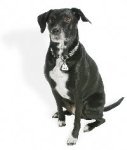Training a Blind Dog: Basic Commands
Some dogs are born blind, while others lose their sight due to age or illness. Training a blind dog, even if it's just the basic obedience commands, is highly recommended as it will help to keep them safe. Vision is only one of a dog's many acute senses but it does have its advantages! By teaching your dog a few commands you can give her the gift of confidence. Here are a few suggestions on training a blind dog:

- Try to always use a familiar area when training
your dog. Without her sight she may become wary or
frightened. You want her to feel as comfortable and
secure as possible.
Remove any objects that your dog could trip over. If possible, make a nice clear area that you can use for training without worrying about having to maneuver your way around.
- Try to keep the layout of your home consistent. Walk your dog around the home several times to help her learn where things are. If you change the location of furniture, or add anything, repeat the process until she can confidently and independently make her way around her home.
- The SLOW command: Use this command when your
dog is about to bump into something. Start by putting
her on a leash. Begin walking. When you want her to
slow down, say "Slow" and simultaneously apply a
gentle pressure to the leash. Praise her and
give her a treat right away when she slows down.
Note: do not say "slow down", as this may confuse your dog into thinking you want her to "slow" as well as "down" (ie. lie down).
- The WAIT command should be taught after
your dog has mastered "Slow". It's used
when you come upon a potentially dangerous situation
and you want your dog to temporarily stay where
she is. For instance, you're about to cross a
street or she's about to walk off a ledge.
Teaching this command is similar to the "Slow" command. Again, put your dog on a leash and begin walking. Apply a steady, gentle pressure to the leash while at the same time saying, "Wait". Reward your dog the instant she stops moving (she doesn't necessarily have to sit - she just needs to stop).
Once she reliably responds to this command on leash, repeat the process while she's off leash. Walk beside her and when you say "Wait", she should stop. Praise her when she does. If she doesn't stop, say "Wait" while applying gentle steady pressure to her collar until she stops. Reward her for stopping.
You will also need a "release word" when you use the Wait command. This word tells your dog it's okay to starting moving again. It can be anything you want, ie. "Okay!", "Let's go!", etc. Say it in an upbeat, happy voice.
- The SIT command. This is a fairly easy thing to teach. Pack your pockets with a bunch of tasty little treats - make sure it's something your really loves! Then hold the treat right by your dog's nose. Say "Sit!" and gradually move the treat upwards (your dog's snout should be following the treat). As your dog raises her nose, she'll naturally move into a sitting position. The instant she's sitting, praise her and give her the treat.
There are some tools to help keep blind dogs safe, such as a
halo Timing is key to successful
dog training,
regardless of whether the dog is blind or whether it still has its
sight. Reward your dog the instant she responds
to a command (and ignore any 'bad' behavior). Lots of
positive reinforcement
will help her to learn the commands, while maintaining the bond you have with
your dog.
.
A halo will prevent the dog from running face-first into an object and
potentially hurt himself. Here are many more tips about
caring for a blind dog
and the best products that can help improve the quality of life for blind dogs..

